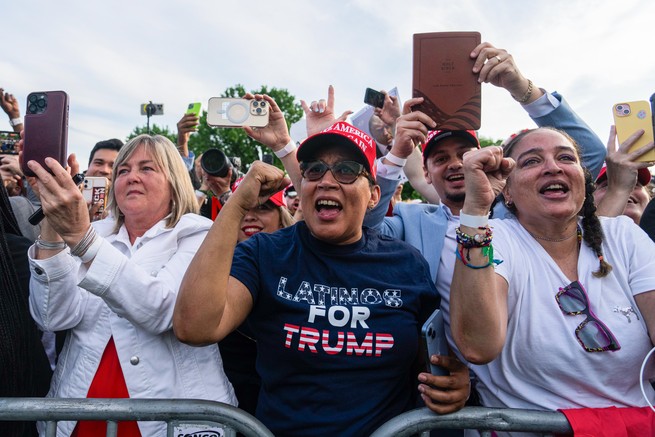As the Republican presidential nominee, Donald Trump, veers into open xenophobia, Vice President Kamala Harris faces a crucial decision about how to respond when she appears today on Univision, the giant Spanish-language television network. Trump’s attacks on immigrants in the past few weeks have grown both sweeping and vitriolic: He is blaming migrants for a lengthening list of problems, even as he describes them in more dehumanizing and openly racist language. As he amplifies these attacks, Trump has also explicitly embraced the kind of eugenicist arguments that were used to justify huge cuts in immigration after World War I, such as his claim this week that Democrats are allowing in undocumented immigrants whose “bad genes” incline them toward murder.
“Certainly, in my lifetime nobody as prominent as Trump has been this intentional, this racist, so consistently—and this all-inclusive in terms of scapegoating,” Julián Castro, the former San Antonio mayor and 2020 Democratic presidential candidate, told me. “We have certainly seen flare-ups in the past, with governors in different states—and even with Trump, of course, in his first term. But this is on another level. And it begs the question of what comes next.”
Harris so far has responded to this Trump onslaught cautiously, and in a tone more of sorrow than of anger. She has often labeled Trump as divisive in general terms. But when talking about immigration, she has focused mostly on presenting herself as tough on border security. She has almost entirely avoided any direct discussion of Trump’s most militant immigration ideas—particularly his proposal to carry out the mass deportation of millions of undocumented migrants.
But Harris will very likely face pressure to offer a more frontal response to Trump’s mass-deportation plan in a town hall she’s holding with Univision in Nevada. With most polls still showing Trump making gains among Latinos since 2020, many Democratic activists and interest groups focused on that community believe that a more forceful rejoinder from Harris to Trump’s intensification of his anti-immigrant rhetoric can’t come too soon.
“We are in the last four weeks of the election, and she needs to be really clear about showing the contrast,” Vanessa Cárdenas, executive director of America’s Voice, an immigration-advocacy group, told me. “It is a missed opportunity for [Democrats] not to lean more into the consequences of this mass-deportation slogan.”
Some immigrant-rights activists and Democratic strategists believe that Harris is so focused on proving her strength on the border that she has become reluctant to criticize almost any element of Trump’s immigration agenda, out of concern that doing so would support his jackhammer portrayal of her as soft on the issue. This debate among Democrats about Harris’s approach to immigration is part of a larger internal conversation that is quietly gathering momentum. Some senior party operatives are privately expressing concern that Harris is spending too much time trying to reassure voters about her own credentials, and not enough making a pointed case against a possible second Trump term. This pattern was starkly apparent in her series of friendly media interviews this week. “Bring a bazooka to a gunfight, please, not a BB gun,” one worried Democratic pollster told me yesterday. Today’s Univision town hall will provide another revealing measure of whether Harris is advancing her case forcefully enough in the campaign’s final stages.
Hostility to immigrants and immigration has been integral to Trump’s political brand from the outset. Yet, even by his standards, the volume and venom of Trump’s attacks on immigrants have amped up sharply during this campaign.
In recent weeks, Trump and his running mate, Ohio Senator J. D. Vance, have insisted that migrants are: stealing jobs from native-born Americans, spurring a national crime wave, driving up housing costs, spreading disease, committing voter fraud, and consuming so many Federal Emergency Management Agency resources that the government doesn’t have enough money to help hurricane victims in North Carolina and Florida. Despite protestations from local officials that the story is a fabrication, Trump and Vance have also insisted that Haitian immigrants in Springfield, Ohio, are stealing and eating residents’ pets.
The other claims have also been debunked. FEMA’s big reserves for responding to natural disasters are held in a congressionally appropriated account that is separate from the funds the agency has for resettling migrants. Violent crime, which rose immediately after the onset of the pandemic, has been declining, and some research suggests that undocumented migrants commit offenses at lower rates than native-born Americans. Despite Vance’s additional claim that Springfield, Ohio, has seen a “massive rise” in communicable disease, local records show that the county-wide rates of such diseases have declined over the past year.
Equally specious is the GOP candidates’ claim that all of the nation’s job growth is accruing to foreign-born workers. Data from the Bureau of Labor Statistics provided by the White House show that nearly 4.5 million more native-born Americans in their prime working years (defined as ages 25 to 54) are employed today than when Trump left office. Contrary to the Trump-Vance claim, this demographic group has added more jobs during President Joe Biden’s term than foreign-born workers have; the share of native-born workers ages 25 to 54 participating in the labor force is higher now than at any point in Trump’s presidency. The latest unemployment rate for native-born Americans in these prime working years is lower than for comparable foreign-born workers.
More ominous even than the multiplying allegations against migrants may be the language Trump is using to describe them. He has said that they are “poisoning the blood of our country,” echoing a formulation used by Adolf Hitler. In Ohio, he said of undocumented migrants, “I don’t know if you call them ‘people,’ in some cases. They’re not people, in my opinion.” Later in the same speech, he called them “animals.” In Wisconsin last month, he said of undocumented immigrants, “They will walk into your kitchen, they’ll cut your throat.” Removing some of the undocumented migrants, Trump mused last month, during another Wisconsin visit, “will be a bloody story.”
Earlier this week, Trump resorted to unvarnished eugenics, twisting federal statistics to argue that the Biden administration has let into the country thousands of murderers. “You know now, a murderer—I believe this—it’s in their genes,” Trump told the conservative talk-show host Hugh Hewitt. “And we’ve got a lot of bad genes in our country right now.” Hewitt chose not to challenge this toxic assertion.
Witnessing this cascade of allegations from Trump and Vance, Erika Lee, a Harvard history professor and the author of America for Americans, told me that she feels a weary sense of “déjà vu” about their anti-immigrant theme—“as if they have dusted off the well-worn playbook that generations of xenophobes have used before.” Nearly every major argument Trump is making, she says, has been made before by nativist campaigners during periods of anti-immigrant backlash.
In 1917, for instance, a Missouri journalist named James Murphy Ward wrote that the great wave of immigrants around the turn of the 20th century was taking jobs from Americans and threatening the nation’s religious traditions. Calling it a “foreign invasion,” he saw their importation as a Catholic plot to undermine the political influence of white American Protestants—this was the Great Replacement theory of his age. The title of Ward’s book would not seem out of place in a political debate today: The Immigration Problem; or, America First. And the most damning example of the immigrant menace that Ward claimed to find has an even more resonant contemporary echo.
“The Chinese laborers who have come to this country, we have been told, are not at all averse to a diet of rats,” Ward wrote, while “the writer himself has heard at least one of these aliens speak of little ‘pups’ as making ‘a fine soup.’”
Harris’s response to Trump’s harsh turn on immigration has been constrained by the Biden administration’s difficulties with the issue. After Congress refused to consider Biden’s legislative proposal to combine tighter border security with a pathway to citizenship for the nation’s population of about 11 million undocumented immigrants, the administration struggled to respond to an unprecedented surge of migrants seeking asylum at the southern border.
The political pressure on Biden ratcheted up last year after Greg Abbott, the Republican governor of Texas, started transporting tens of thousands of migrants to northern cities, straining local resources and prompting loud complaints from some Democratic mayors and governors. Finally, in January, Biden endorsed a bipartisan Senate plan led by the conservative James Lankford of Oklahoma that proposed to severely restrict opportunities to seek asylum.
When Lankford’s Republican colleagues abandoned the plan after Trump denounced it, Biden moved in June to use executive action to implement some of its key provisions that narrow opportunities for asylum. The new rules have reduced the number of migrants seeking asylum by as much as three-fourths since late last year, according to an analysis by the Pew Research Center. But the political damage was done. Polls consistently showed that Americans: disapproved of Biden’s performance on the border in larger numbers than on any other issue except inflation; by a big margin, trusted Trump more than Biden to handle the problem; and were growing more open to Trump’s hard-line solutions, including building a border wall and carrying out a mass deportation of undocumented immigrants already in the country. In July, Gallup found that the share of Americans who wanted to reduce immigration had reached 55 percent, the highest level since soon after the terrorist attacks on September 11, 2001. Republican groups, sensing a Democratic vulnerability, have spent heavily on ads portraying Harris—whom Biden early on appointed to deal with the root causes of migration—as weak on the border.
These headwinds have encouraged Harris to center her immigration messaging on convincing the public that she would be tough enough to secure the border. She has emphasized her experience as a prosecutor and as California’s attorney general pursuing “transnational gangs,” as well as promising to tighten Biden’s limits on asylum even more. She has also hugged the bipartisan Senate compromise that Trump derailed—similarly to the old political analysts’ joke about Rudolph Giuliani and the 9/11 terror attacks, a typical sentence on immigration for Harris is Noun, verb, Lankford.
Harris has coupled these promises of tougher enforcement with the traditional Democratic promise to “create, at long last, a pathway to citizenship for hardworking immigrants who have been here for years,” as she put it in Arizona last month during a set-piece speech on immigration. Yet she has almost completely avoided discussing Trump’s mass-deportation plan.
Implicitly, Harris’s agenda rejects any such scheme, because the longtime residents for whom she would provide a path to legalization are among those Trump would deport. Apart from a passing reference in a speech last month to the Congressional Hispanic Caucus Institute, however, she has not explicitly criticized the Trump plan; nor has Harris discussed at any length how the proposal would disrupt immigrant communities and harm the economy. When her running mate, Tim Walz, was asked directly about Trump’s deportation agenda during the vice-presidential debate earlier this month, he responded by talking almost entirely about the Lankford bill himself. Walz has called the language from Trump and Vance about immigrants “dehumanizing,” but Harris has tended to wrap Trump’s attacks on immigrants into a more generalized lament about his divisiveness.
Amid the campaign sparring on immigration, Trump has seemed to be enjoying a double dividend: He has energized his core support of culturally conservative whites with vehement anti-immigrant language and has gained ground, according to most polls, with Latino voters, even as Latino communities would be the principal targets of his deportation plans. Although polls show Harris recovering much of the ground Biden had lost among Latinos, she is still lagging the level of support he had in 2020, particularly among Latino men.
Polls of the Latino community have consistently found that, like other voters, they are more concerned about the economy than immigration. Surveys also show a slice of Latino voters who, departing from the view among advocacy groups, feel that recent asylum seekers are, in effect, jumping the line—and this has moved them toward Trump’s hard-line approach.
But Carlos Odio, a Democratic pollster who focuses on Latino voters, says surveys show that support for mass deportation plummets among not only Latinos but also other voters when “people learn that Trump’s plans are to deport [undocumented] people who have been living and working here for decades.” So Trump is holding his elevated Latino support despite that opposition to mass deportation, Odio told me, in large part because most Latinos “don’t actually believe any of this stuff is going to happen”; they expect that the courts, Congress, or business groups would prevent him from pursuing widespread removals.
Odio, the senior vice president for research at the polling firm Equis, believes that Harris has run an effective campaign to regain much of Biden’s lost ground among Latino voters, but he thinks she could benefit from more forcefully targeting Trump’s enforcement agenda, including mass deportationand his refusal to rule out again separating migrant children from their parents at the border. (Given that nearly 4 million U.S.-citizen children have at least one undocumented parent, Trump’s deportation agenda could be said to amount to a mass family-separation policy as well.) “There has been such a desire to tamp down the border debate [that] there’s been less of an ability to pivot to other parts of the immigration debate that could be helpful,” Odio told me. Even conservative Latinos who moved toward Trump, he notes, overwhelmingly opposed his family-separation policies in an Equis post-2020 election survey.
Castro likewise thinks Harris’s overall approach to Latino voters has been sophisticated, but he worries that the reluctance that she, along with almost all other prominent Democrats, shows to challenging the mass-deportation proposal is “moving the Overton window” and normalizing the plan. “There’s not enough pushback on it,” Castro told me. “The consequence of not pushing back is that more people believe that something like mass deportation is a reasonable, moral policy choice, which is completely wrong.”
The history of immigration politics is that it tends to be what political scientists call a “thermostatic” issue, meaning that public opinion moves left when a president moves right (as happened under Trump) and right when a president moves left (as happened for most of Biden’s presidency). That pattern underscores the likelihood that enforcement of a Trump mass-deportation program—complete with TV images of mothers and children herded onto buses, even detained behind the barbed-wire fences of internment camps—would face much more public resistance in practice than polls suggest today.
Yet Lee, the Harvard historian, says that the previous eruptions of anti-immigrant agitation show how great a challenge the more explicit xenophobia that Trump has catalyzed could present in the years ahead. Although many scholars believe that xenophobia flourishes primarily during periods of economic distress, Lee says that a more common factor in the past “has been the effectiveness of the messenger and the medium.” For instance, she told me, the first great wave of 19th-century anti-Catholic agitation “spread through newspapers and newly available cheap novels”; then the anti-Chinese propaganda a few decades later “spread through even more newspapers and illustrated magazines.”
Those distribution systems for anti-immigrant ideas pale next to what we’re seeing today, Lee believes. “Now we have a 24/7 news cycle, organized networks pushing content, plus social-media platforms that broadcast xenophobia around the world as it happens,” she told me. “As a result, xenophobia today feels both frighteningly familiar and devastatingly more widespread and violent than other periods in history.”
Harris and other Democrats have tactical incentives to avoid a full-on confrontation with those sentiments in the final weeks before next month’s election. But the history of America’s experience with xenophobia indicates that Trump’s lurid attacks will only find a larger audience unless Harris, and others who believe in a more inclusive society, challenge them more directly than they have so far.





